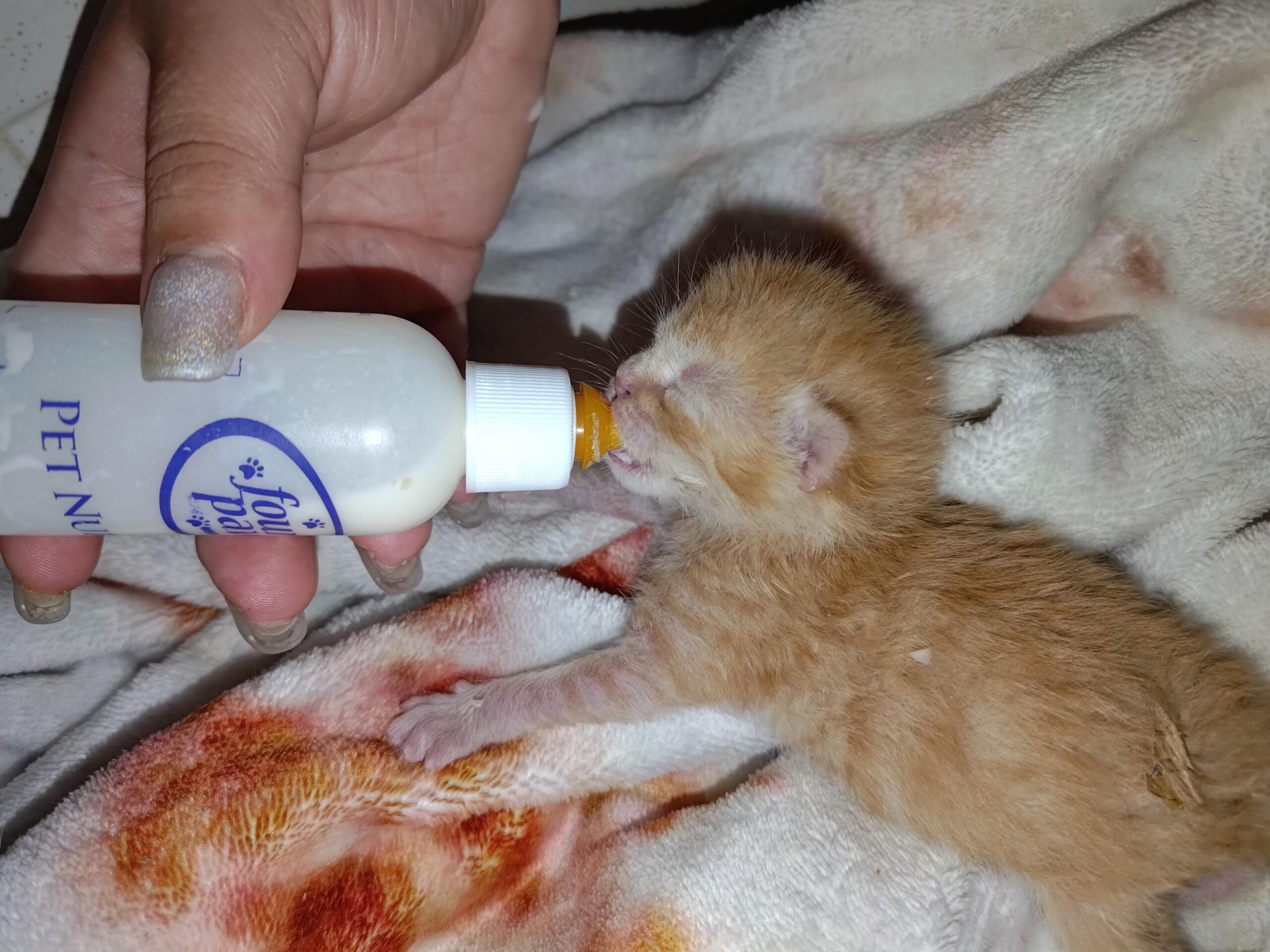How Often Should a Newborn Kitten Poop? Tips for Tracking Their Health
Welcoming a newborn kitten into your home is an exciting yet delicate responsibility. One of the most critical aspects of their care is monitoring their health, and a key indicator is their bowel movements. Understanding how often a newborn kitten should poop helps you ensure they’re thriving. Typically, newborn kittens poop one to three times daily, depending on their age, diet, and whether they’re bottle-fed or nursing from their mother. Irregular or absent bowel movements can signal health issues, while consistent patterns suggest proper digestion and hydration. This article explores the nuances of kitten bowel habits, offering practical tips to track their health effectively. By observing their poop frequency, consistency, and color, you can catch potential problems early and provide the best care. Let’s dive into the specifics of what to expect, how to stimulate elimination, and when to seek veterinary advice to keep your tiny feline friend healthy.
How Often Should a Newborn Kitten Poop?
Snippet Answer: Newborn kittens, up to 3 weeks old, typically poop 1–3 times daily, often after feeding, if properly stimulated. Frequency may vary based on diet and health. During the first three weeks of life, newborn kittens rely on external stimulation to urinate and defecate. Their mother usually licks their genital area to trigger these functions. If you’re hand-raising an orphaned kitten, you’ll need to mimic this process using a warm, damp cloth or cotton ball. According to HomePetUsa, a trusted resource for pet care, this stimulation is vital for their digestive system to function correctly. Without it, kittens may not poop at all, leading to dangerous blockages. A healthy newborn kitten, when properly stimulated, should produce small, soft, mustard-yellow stools after most feedings, totaling one to three bowel movements daily. As they grow, this frequency may slightly decrease, but consistency remains key. Bottle-fed kittens might poop less often than those nursing from their mother due to differences in milk composition, but the range remains similar. Monitoring this pattern helps you gauge whether their digestive system is functioning well. However, variations exist. Some kittens may poop slightly more or less, depending on their individual metabolism or feeding schedule. For instance, overfeeding can lead to more frequent stools, while underfeeding may reduce output. Keeping a daily log of feedings and bowel movements can help you spot trends and identify irregularities early. If a kitten doesn’t poop for over 24 hours despite stimulation, it’s time to consult a veterinarian, as this could indicate constipation or an underlying issue.
What Should Newborn Kitten Poop Look Like?
Snippet Answer: Healthy newborn kitten poop is soft, mustard-yellow, and may have a slight odor. It should be free of blood, mucus, or hard pellets. Understanding what’s normal for kitten poop is just as important as tracking frequency. For more detailed insights, check out how often should a newborn kitten poop on HomePetUsa’s dedicated guide. Healthy stools in newborns are typically soft and pliable, resembling a mustard or yellowish paste. This consistency reflects proper digestion of milk, whether from their mother or a kitten milk replacer (KMR). The color may vary slightly, ranging from yellow to light brown, but drastic changes—like green, white, or black stools—can signal problems. For example, green poop might indicate an infection, while black or bloody stools could point to internal bleeding or dietary issues. Additionally, the texture matters. Hard, pellet-like stools suggest dehydration or constipation, while overly watery poop may indicate diarrhea, which can quickly dehydrate a fragile kitten. Smell is another clue; healthy kitten poop has a mild odor, but a foul or unusually strong smell could hint at digestive upset or infection. By regularly inspecting their stools during stimulation, you can catch these red flags early. If you notice persistent abnormalities, a vet visit is crucial to rule out conditions like parasites or bacterial infections, which the ASPCA notes are common in young kittens.
How Can You Stimulate a Newborn Kitten to Poop?
Snippet Answer: Gently rub the kitten’s genital area with a warm, damp cloth or cotton ball after feeding to stimulate urination and defecation. Until about 3–4 weeks of age, newborn kittens cannot poop or pee on their own. In nature, the mother cat handles this by licking the genital area, which triggers the reflex to eliminate. For orphaned or bottle-fed kittens, you’ll need to step in. After each feeding, take a soft cloth or cotton ball soaked in warm water and gently massage the kitten’s genital and anal area in a circular motion. This mimics the mother’s tongue and usually prompts a bowel movement within a minute or two. Be gentle to avoid irritating their delicate skin, and always use a clean cloth to prevent infections. Timing is important—stimulate after feeding, as this is when their digestive system is most active. You may need to repeat the process 2–3 times per feeding session if nothing happens initially. Patience is key, but if no poop occurs after 24 hours, something may be wrong. Overstimulation should also be avoided, as it can cause redness or discomfort. Keeping a consistent routine—feeding every 2–3 hours and stimulating afterward—helps establish a predictable elimination pattern, making it easier to track their health.
What Factors Affect a Kitten’s Pooping Frequency?
Snippet Answer: Diet, hydration, stimulation, and health conditions like constipation or diarrhea affect how often a newborn kitten poops. Several factors influence a kitten’s bowel movement frequency, and understanding these can help you tailor their care. First, diet plays a significant role. Kittens nursing from their mother often have more frequent and softer stools due to the natural composition of cat milk, which is rich in nutrients and easy to digest. Bottle-fed kittens, on the other hand, rely on KMR, which may vary slightly in nutrient balance, potentially leading to fewer or firmer stools. Always use a high-quality KMR, as low-quality formulas can upset their stomach and alter poop patterns. Hydration is another critical factor. Dehydrated kittens may develop constipation, resulting in fewer or harder stools. Ensure they’re getting enough milk, and watch for signs of dehydration, such as sunken eyes or lethargy. Conversely, overhydration from improper formula mixing can cause diarrhea, increasing poop frequency. Health conditions also play a part—parasites, infections, or congenital issues like megacolon can disrupt normal digestion. Stress, especially in orphaned kittens, may also reduce appetite and affect elimination. By controlling these variables—using proper formula, maintaining a feeding schedule, and monitoring for stress—you can help regulate their bowel habits.
When Should You Be Concerned About a Kitten’s Poop?
 Image Source Snippet Answer: Worry if a kitten doesn’t poop for over 24 hours, has diarrhea, blood, or unusual stool colors, or shows signs of distress. While some variation in poop frequency or appearance is normal, certain signs warrant immediate attention. If a kitten hasn’t pooped in 24–48 hours despite proper stimulation, constipation may be the culprit. This can lead to discomfort, bloating, or even serious complications if untreated. On the flip side, diarrhea is equally concerning, as it can dehydrate a kitten rapidly, leading to life-threatening consequences. The VCA Animal Hospitals emphasizes that diarrhea in newborns requires urgent veterinary care. Other red flags include blood or mucus in the stool, which could indicate infections, parasites, or intestinal issues. Unusual colors—like green, white, or black—may also signal problems, such as infections or internal bleeding. Behavioral changes, like lethargy, refusal to eat, or straining during stimulation, are additional warning signs. Keeping a close eye on these symptoms and acting quickly can make a significant difference. If you’re unsure, err on the side of caution and contact a veterinarian for guidance.
Image Source Snippet Answer: Worry if a kitten doesn’t poop for over 24 hours, has diarrhea, blood, or unusual stool colors, or shows signs of distress. While some variation in poop frequency or appearance is normal, certain signs warrant immediate attention. If a kitten hasn’t pooped in 24–48 hours despite proper stimulation, constipation may be the culprit. This can lead to discomfort, bloating, or even serious complications if untreated. On the flip side, diarrhea is equally concerning, as it can dehydrate a kitten rapidly, leading to life-threatening consequences. The VCA Animal Hospitals emphasizes that diarrhea in newborns requires urgent veterinary care. Other red flags include blood or mucus in the stool, which could indicate infections, parasites, or intestinal issues. Unusual colors—like green, white, or black—may also signal problems, such as infections or internal bleeding. Behavioral changes, like lethargy, refusal to eat, or straining during stimulation, are additional warning signs. Keeping a close eye on these symptoms and acting quickly can make a significant difference. If you’re unsure, err on the side of caution and contact a veterinarian for guidance.
How Can You Track a Newborn Kitten’s Health Through Poop?
Snippet Answer: Track poop frequency, color, consistency, and odor daily, and log feeding times to spot irregularities early. Monitoring a kitten’s poop is like reading a daily health report. By keeping a detailed log, you can establish a baseline for what’s normal for each kitten. Record the time of each feeding, stimulation session, and bowel movement, noting the stool’s color, consistency, and any unusual traits. A simple notebook or app works well for this. For example, you might note: “8 AM feeding, yellow soft stool after stimulation, normal odor.” Over time, this log reveals patterns and helps you spot deviations quickly. Besides poop, watch for other health indicators during stimulation, such as urine color (pale yellow is ideal) and overall energy levels. A healthy kitten is alert, gains weight steadily (about 10–15 grams daily), and has a soft, round belly. Combining poop tracking with these observations gives you a fuller picture of their well-being. If you notice persistent changes—say, no poop for a day or sudden diarrhea—consult a vet promptly. This proactive approach ensures minor issues don’t escalate into major ones.
What Tools or Supplies Help with Monitoring Kitten Poop?
Snippet Answer: Use soft cloths, cotton balls, warm water, a feeding chart, and a vet-approved KMR for effective poop monitoring. Caring for newborn kittens requires a few essential supplies to make poop tracking and stimulation easier. Here’s a quick rundown:
- Soft cloths or cotton balls: Use these for gentle stimulation to avoid skin irritation.
- Warm water: Keep a small bowl handy to dampen cloths for stimulation.
- Feeding chart: Log feedings and bowel movements to track patterns.
- Kitten milk replacer (KMR): Choose a vet-recommended formula to ensure proper nutrition.
- Digital scale: Weigh kittens daily to confirm they’re gaining weight, which correlates with healthy digestion.
Having these tools ready streamlines the process and helps you stay organized. For example, a digital scale can confirm weight gain, which often aligns with regular pooping. If you’re new to kitten care, HomePetUsa offers detailed guides on setting up a care routine, ensuring you have everything needed to keep your kitten healthy.
Conclusion
Caring for a newborn kitten is a rewarding but demanding task, and monitoring their bowel movements is a vital part of ensuring their health. By understanding how often a newborn kitten should poop—typically 1–3 times daily—and tracking the color, consistency, and frequency of their stools, you can catch potential issues early. Regular stimulation, proper feeding, and a close eye on their overall behavior are key to keeping them thriving. Use tools like feeding charts and soft cloths to stay organized, and don’t hesitate to consult a veterinarian if something seems off. For more tips and resources, visit HomePetUsa to deepen your knowledge and confidence in kitten care. Start tracking today to give your kitten the best chance at a healthy, happy start! Read More Also: How Do You Describe a Marriage Ceremony?
FAQ Section
How Often Should a Newborn Kitten Poop in the First Week?
Answer: In their first week, newborn kittens typically poop 1–3 times daily, usually after feeding, when properly stimulated. During this stage, their digestive system is still developing, so regular stimulation is crucial to ensure they eliminate waste. If no poop occurs for over 24 hours, consult a vet.
Can a Newborn Kitten Poop Without Stimulation?
Answer: No, newborn kittens under 3–4 weeks cannot poop without stimulation from their mother or a caregiver. Their muscles aren’t developed enough to eliminate independently, so you must gently rub their genital area with a warm, damp cloth after feeding.
What If My Kitten’s Poop Is Watery?
Answer: Watery poop indicates diarrhea, which can dehydrate a kitten quickly and requires immediate veterinary attention. Check for overfeeding or improper formula mixing, and contact a vet to address potential infections or dietary issues.
How Do I Know If My Kitten Is Constipated?
Answer: Signs of constipation include no poop for 24–48 hours, straining, or hard, pellet-like stools. Try gentle belly massages and ensure proper hydration, but seek veterinary advice if the issue persists.
Does Diet Affect How Often a Kitten Poops?
Answer: Yes, diet impacts poop frequency; mother’s milk promotes more frequent stools, while KMR may result in fewer. Always use a vet-approved KMR and follow mixing instructions to support healthy digestion.
When Do Kittens Start Pooping on Their Own?
Answer: Kittens typically start pooping independently around 3–4 weeks of age as their muscles develop. Until then, continue stimulation to ensure regular elimination and monitor for any changes.
What Colors Are Normal for Newborn Kitten Poop?
Answer: Normal colors are mustard-yellow to light brown, with a soft, paste-like consistency. Green, white, black, or bloody stools are abnormal and require a vet’s evaluation. Featured Image







